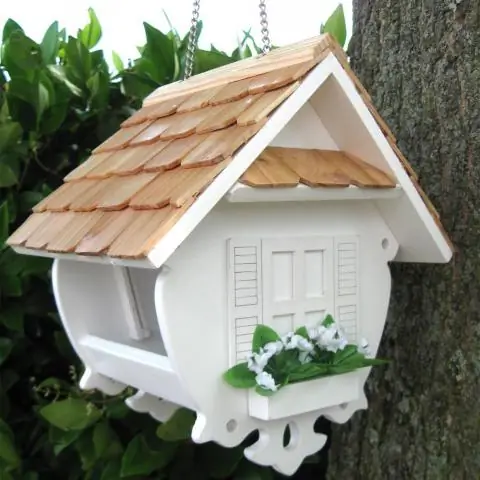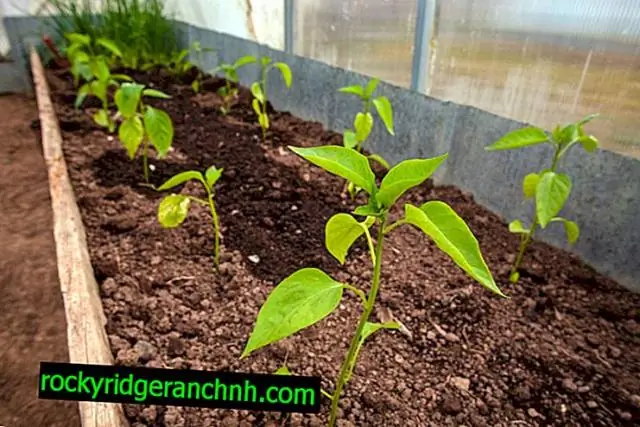
Table of contents:
- Author Bailey Albertson [email protected].
- Public 2024-01-17 22:26.
- Last modified 2025-06-01 07:32.
Rules for growing strawberries in a greenhouse all year round

Strawberries are a fully-fledged and universally recognized berry queen. Its taste and aroma are loved by both adults and children. Unfortunately, eating fresh strawberries in the cold season is difficult. You can provide yourself with it in the winter thanks to growing berries in a greenhouse.
Content
- 1 Growing strawberries all year round - myth or reality?
-
2 Preparatory phase
- 2.1 Greenhouse
- 2.2 Organization of temperature and humidity conditions
- 2.3 Light mode
- 2.4 Equipment
-
2.5 Suitable varieties
2.5.1 Greenhouse cultivars (gallery)
- 2.6 Preparing the beds
- 2.7 Soil preparation
- 2.8 Preparing seedlings
- 3 Growing technology
-
4 Planting care
- 4.1 Pollination
- 4.2 Prevention of diseases and pests
- 5 Growing strawberries in a greenhouse (video)
Growing strawberries all year round - myth or reality?
Almost every owner of a summer cottage has at least a small bed of strawberries. This is usually enough to pamper yourself with fresh berries and even provide the family with jam and compote for the winter. But you want delicacies not only in summer, but also in the cold season.
Of course, you can buy strawberries from the store if needed. But, firstly, in winter this berry is very expensive, and secondly, many are alarmed by the methods of growing in artificial conditions using growth stimulants and GMOs.
There is only one way out: start growing strawberries on your own. So you can provide seven berries, and even build a profitable business on this. But how real is it?

Growing strawberries in a greenhouse is possible in mid and northern latitudes
Until recently, one could say that this is impossible at home. But in our time, when industrial technologies become available to private consumers, everyone can grow strawberries all year round. A good greenhouse, built and equipped according to the rules, will help with this. The main thing to ensure is:
- heating;
- lighting;
- irrigation.
In addition, it is necessary to select suitable strawberry varieties, prepare the soil, and in the future do not forget about proper berry care. And if you can easily cope with these requirements on your own, then it is better to entrust the construction and equipment of the greenhouse to professionals.
Don't forget that growing strawberries all year round is not easy and costly. If you want to "recoup" the invested funds and efforts, you have to work a lot
Preparatory stage
Greenhouse
You can build a greenhouse in your garden by defining a plot for it, the soil on which is best suited for composition. There are 3 main types of structures of this kind.
- The most affordable option is a wooden frame with a film coating. The design is short-lived; you will have to replace the film with a new one every season. In addition, in a harsh winter, such a coating is not considered reliable.
- A steel profile as a supporting structure, covered with cellular polycarbonate - such a greenhouse is lightweight, but strong at the same time. The cost is higher than the first option.
-
Glass covering on a steel frame is the most durable, reliable and durable structure. Ideal for creating the necessary conditions inside.

winter greenhouse for strawberries Installing a greenhouse from quality materials and its equipment is the first step to large yields
Organization of temperature and humidity conditions
In order for strawberries to grow normally in the greenhouse, you need to provide a gentle rise in air temperature. In cool conditions, the flowering process of this culture is significantly delayed. In addition, the moisture level is very important.
Strawberry is a thermophilic plant, for which temperature is very important
- During disembarkation, the optimum temperature is + 10 ° C.
- Gradually raise the reading to + 20 ° C as it grows.
- When the strawberries begin to bloom, keep the temperature between +20 and + 24 ° C.

For strawberries in the greenhouse, you need to provide moisture, light and warmth
Light mode
There are strawberry varieties with neutral daylight hours (allowing low light levels). But even they need light, especially during the flowering period. The duration of flowering and fruiting depends on the intensity of lighting.
Equipment
In order to ensure the normal level of light, humidity and temperature in the greenhouse, especially in winter, special equipment will be needed.
To maintain a normal humidity level, it is enough to spray the greenhouse using spray guns or sprinklers. At the same time, avoid getting water on the leaves and flowers of the plant. Excessive watering will also not be beneficial: strawberries may die from an excess of moisture. To avoid this, install a drip irrigation system for greenhouses.

Drip irrigation system will avoid excess moisture
When choosing such a system, pay attention to the area of the territory occupied by a greenhouse with strawberries. Water consumption for irrigation should be adjusted at the rate of 3 liters per day per 1 m of the length of the garden bed or container.
Such a system can be done with your own hands from improvised means.
- Install a barrel or other container for liquid of the required volume 0.5 m above the level of the beds.
- Attach a long hose to it, run it along the bottom of the strawberry containers (or in the recess in the middle of the garden bed), and make a plug at the end.
- Make small holes along the entire length of the hose at a distance of 3-5 cm: through them water will flow into the ground.
For the autumn-winter period, the greenhouse must be provided with additional lighting. In addition to the fact that daylight hours are significantly reduced, and the sun is often hidden behind clouds, greenhouses used in the cold season usually have design features that create high shading. Install high pressure sodium lamps to deal with this.

It is very important to choose and install lighting fixtures correctly
They need to be located at a height of 1 m above the strawberry garden. Calculate the required number of devices based on the fact that for 3 square meters. m. there should be 1 lamp.
As far as heating is concerned, the best option would be to connect the greenhouse to an indoor heating system
Suitable varieties
If you want to get a high-quality harvest, then you need to choose berry varieties according to at least two criteria.
- Optimal climatic conditions for strawberries. In this case, you need to pay attention to the weather conditions inherent in your lane. We recommend purchasing seedlings from nurseries located in your region. This will allow you to get the strawberries already acclimatized.
- Ripening terms. The ideal option would be to organize several beds with strawberries of varieties of different ripening duration. Thus, you will not only be able to harvest several crops from June to the end of September, but you will also have seedlings on hand for further cultivation in the greenhouse.
In the conditions of the middle zone and colder regions (Ural, Siberia, Far East), self-pollinated remontant varieties are recognized as optimal for growing in greenhouses. They usually have an early ripening period, which means that the harvest will be good even with a thickened planting. In addition, if these varieties belong to the group of neutral daylight hours, then they do not require long-term intense lighting.

Choose specially bred varieties for greenhouse cultivation
The most popular varieties suitable for growing in our latitudes:
- Pineapple;
- Arapaho;
- Brighton;
- Mount Everest;
- Darselect;
- Elizabeth II;
- Yellow miracle;
- Zenga Zengana;
- Temptation;
- Queen Elizabeth;
- Crown;
- Marmalade;
- Maria;
- Mahern;
- Moscow delicacy;
- Darkness;
- Ozark Beauty;
- Polka;
- Professional;
- Red Rich;
- Sakhalin;
- Selva;
- Sonata;
- Tribute;
- Truffau Producer;
- Tristar;
- Honey;
- Elsanta.
Modern breeding has given us many varieties that are self-pollinating, but with classic varieties, pollination will have to be done manually.
Greenhouse strawberry cultivars (gallery)
-

Elsanta variety - Elsanta
-

grade Honey - Honey
-

grade Marmalade - Marmalade
-

Zenga Zengana variety - Zenga Zengana
-

grade Yellow miracle - Yellow miracle
-

grade Elizabeth II - Elizabeth II
-

Mount Everest variety - Mount Everest
Preparing the beds
The correct organization of the beds will help you make the most efficient use of the usable area of the greenhouse. In addition, you will provide the strawberry bushes with the necessary nutrition, lighting and irrigation. The best option is considered to be growing not on the ground, but in hanging containers.
For containers, arrange for all-welded metal profile bases that can withstand heavy loads. The width of the finished frame should be about 1 meter, the length is equal to the length of the greenhouse, and along the edges there are 2 longitudinal sections for containers 20 cm wide.
Soil preparation
Regular garden soil is not suitable for year-round strawberry cultivation. For continuous fruiting, you need to provide a highly nutritious environment. To prepare 1 ton of substrate, you will need:
- 300 kg of chicken manure;
- 650 kg of straw (preferably from winter wheat or oats);
- 6 kg of chalk;
- 20 kg of gypsum;
- 3 kg of urea.
All components are readily available, you just have to properly compost them. To do this, put in a pile in layers in this order:
- Straw layer 25 cm thick.
- Chicken droppings - 10 cm
- Urea at the rate of 400 grams per 100 kg of straw.
Repeat layers until a pile is formed about 1.5 m wide and up to 2 m high. Water each layer well with warm water. In a few days, the fermentation of the components will begin, which will last about a month. During this time, you need to mix the compost, that is, mix it:
- the first time - 10-12 days from the beginning of fermentation;
- the second - after 17 days;
- the third - after 25 days.
Seedling preparation
Strawberries are cultivated as an annual plant, so the quality of the planting material is very important. We have already said that it is most convenient to purchase strawberry seedlings of suitable varieties in the nursery. But you can use the berries that grow in your garden in the open field.
-
Select bushes for mother plantation in June, after the first strawberries ripen. Mark those bushes on which the berries ripen the fastest. After the harvest is harvested, a mustache will appear. Leave a maximum of 5 outlets on each of the marked bushes, remove the rest.

strawberry seedlings As seedlings, you can use those berries that grow in your garden in the open field
-
Until August, reduce the care of planting material to regular loosening of the soil. During this time, the strawberry will develop a good root system. Transplant the bushes into a prepared nursery-garden with a fertile substrate according to the 15 X 15 cm pattern. Seedling boxes can be used in the same capacity.

seedlings with roots Until August, reduce the care of the planting material to loosening the soil, during which time the strawberries will form a good root system
- At the end of autumn, before frost, transplant the seedlings into pots with nutritious soil, removing all the leaves. Move to a basement or other room where the temperature does not reach below -2 ° C. In these conditions, store containers with seedlings for up to 9 months. Transplant seedlings to the greenhouse when needed.
Growing technology
Today, the Dutch method of growing strawberries in a greenhouse has become very popular. It is simple and affordable, ideal for small areas (you can use it not only in the greenhouse, but even on the balcony), and allows you to get several high yields throughout the year.
The essence of the technology lies in the use of special film sleeves for growing, which are filled with a substrate of perlite and steamed peat. This mixture has a high level of hygroscopicity, that is, it absorbs moisture 4 times more than its own volume, while simultaneously saturating it with useful substances. At the same time, flowers and fruits do not come into contact with the ground, which protects them from decay.
Dutch technology has 2 main options. The choice may depend on the available space in the greenhouse. The methods can be combined if desired.
- Horizontal placement of bags - the bushes are planted in a checkerboard pattern at a distance of 25-30 cm from each other. The bags are arranged in several levels with a gap of 0.5 meters. The disadvantages of this method include the need to organize lighting: its intensity should be equal for all strawberry bushes.
- Vertical - you can use polymer pipes with cutouts 5-7 cm in diameter. Place them in several rows at a distance of 25-30 cm in height from each other. Fix the structures in an upright position.

Dutch technology for growing strawberries is recognized as the simplest and most convenient
Planting care
For a good harvest, it is important to properly care for your strawberries. Above we have already talked about how to maintain light and temperature conditions, as well as humidity in the room used.
- Be sure to provide your greenhouse strawberries with 8-10 hours of additional lighting a day, at least from December to early March.
- Remember to gradually increase the temperature in the greenhouse from the moment the buds form.
- Control the humidity in the greenhouse.
- Be sure to provide fertilizing with fertilizers. For example, once every 2 weeks use the following mixture: for 10 liters of water - 10 g of potassium salt and 80 g of superphosphate with ammonium nitrate.
Pollination
When growing strawberries in greenhouse conditions, pollination will have to be done manually. Alternatively, you can start a small hive with bees or bumblebees, but this is too laborious. Therefore, it is better to arm yourself with a soft brush. You can buy it at any stationery store.
Pollination should be carried out as follows: 2-3 times a day, gently brush over the flower, collecting pollen, and then transfer it to another flower. It is very important that at this time the air humidity in the greenhouse is low.
Prevention of diseases and pests
The main enemy of strawberries is gray rot. It is very difficult to treat it, it is much easier to prevent its appearance. To do this, control the humidity level in the greenhouse, do not allow it to rise to a critical level.

Apply fungicides during the flowering period of the strawberry, until the petals fall
Periodically use a fungicide for spraying: it is applied by a drop method to the root zone. This should be done during the flowering period of the strawberry, until the petals fall off.
Heat and humidity often provoke slugs. You can get rid of them with special traps, which can be purchased at any hardware store.
Growing strawberries in a greenhouse (video)
Growing strawberries all year round in a greenhouse is a very time consuming task, but such work (with the proper approach) can bring you considerable income. Fresh juicy berries are always in demand among the population. Tell us in the comments about your experience in growing strawberries. Good luck to you!
Recommended:
Important Rules On How To Protect Strawberries From Birds + Video

The most effective ways to protect strawberries from birds: nets, deterrents, and others. What methods don't work exactly? What do experienced gardeners use?
Description And Rules For Growing Cucumber Varieties Amur F1 + Video

Features and description of the parthenocarpic variety Amur F1. How to properly grow cucumber seedlings, feed the plant and harvest. Reviews of gardeners
Growing Pepper Seedlings At Home: When To Plant According To The Lunar Calendar 2019, On The Windowsill, In The Greenhouse And Not Only With Video

How to prepare everything you need for growing pepper seedlings at home, sow seeds and grow in a suitable way for a gardener
Seedlings Of Eggplant At Home: Planting According To The Lunar Calendar 2019, Features Of Growing In Different Ways, Rules For Leaving With Video

How does growing eggplant seedlings differ from growing any other, why you need to do it and how to avoid mistakes when planting at home
How To Freeze Strawberries With Sugar For The Winter + Video

How to properly freeze strawberries with sugar: whole berries and mashed berries. Simple and proven recipes for making strawberries for the winter
